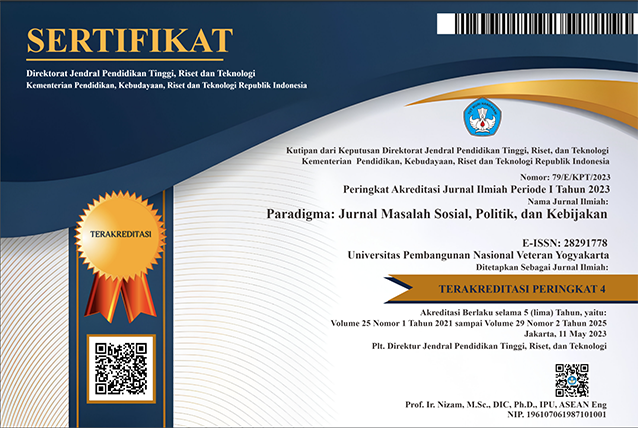Kemampuan Absorptif Sebagai Variabel Mediasi pada Pengaruh Orientasi Kewirausahaan Terhadap Keunggulan Kompetitif
DOI:
https://doi.org/10.31315/paradigma.v26i1.6610Keywords:
Orientasi kewirausahaan, kemampuan absorptif, keunggulan kompetitifAbstract
Penelitian ini bertujuan untuk mengeksplorasi pengaruh antara orientasi kewirausahaan (EO), keunggulan kompetitif (CA) dan kemampuan absorptif (AC) pada UKM kerajinan kulit dan apakah kemampuan absorptif memediasi hubungan antara orientasi kewirausahaan dan keunggulan kompetitif. Paradigma keunggulan kompetitif terutama pada UKM seringkali masih berhadapan dengan rendahnya kemampuan mereka untuk mencapai keunggulan kompetitif. Sumber daya yang terbatas dan ketidakberanian mengambil risiko serta pengetahuan yang terbatas menjadi beberapa kendala yang dihadapi UKM. Penelitian ini bertujuan untuk menganalisis permasalahan tersebut dengan menguji orientasi kewirausahaan dan keunggulan kompetitif serta kemampuan absorptif. Penelitian korelasional ini mengumpulkan data menggunakan kuesioner. Jumlah responden sebanyak 120 UKM dari 4 kabupaten dan 1 kota di wilayah Provinsi Yogyakarta dengan tingkat respon 70%. Sampel dipilih menggunakan metode simple random sampling untuk menanggapi kuesioner yang diberikan. Pengukuran dan model struktural dinilai menggunakan analisis Hierarchical regression analysis. Hasil analisis menunjukkan bahwa kemampuan absorptif memediasi antara hubungan innovativeness, risk taking dan proactiveness terhadap keunggulan kompetitif. Pada jalur pengaruh antara innovativeness dan risk taking terhadap keunggulan kompetitif, kemampuan absorptif merupakan variabel mediasi sempurna, sementara pada proactiveness terhadap keunggulan kompetitif merupakan variabel mediasi parsial. Temuan ini mengkonfirmasi pandangan berbasis pengetahuan, yang menyatakan bahwa orientasi kewirausahaan dan kemampuan absorptif sebagai sumber daya tidak berwujud dapat menciptakan nilai dalam pengembangan produk dan hasil-hasilnya, Orientasi kewirausahaan dan kemampuan absorptif mampu membawa pelaku usaha kerajinan menciptakan keunggulan kompetitif. Keterbatasan penelitian ini adalah variabel kemampuan absorptif relatif jarang digunakan terutama untuk UKM sehingga persepsi subjektivitas responden masih sangat kuat.
References
Adriansyah, A., & Afiff, A. Z. (2015). Organizational Culture, Absorptive Capacity, Innovation Performance and Competitive Advantage : an Integrated Assessment in Indonesian Banking Industry. The South East Asian Journal Of Management, 9(1), 70. Retrieved from http://journal.ui.ac.id/index.php/tseajm/article/viewFile/4376/3209
Atuahene-Gima, K., & Ko, A. (2001). An Empirical Investigation of the Effect of Market Orientation and Entrepreneurship Orientation Alignment on Product Innovation. Organization Science, 12(1), 54–74.
Avolio, B. J., Walumbwa, F. O., & Weber, T. J. (2009). Leadership: current theories, research, and future directions. Annual Review of Psychology, 60(1), 421–449. https://doi.org/10.1146/annurev.psych.60.110707.163621
Barney, J. (1991). Firm Resources and Sustained Competitive Advantage. Journal of Management, 17(1), 99–120. https://doi.org/10.1177/014920639101700108
Baron, R. M., & Kenny, D. A. (1986). The Moderator-Mediator Variable Distinction in Social Psychological Research: Conceptual, Strategic, and Statistical Considerations. Journal of Personality and Social Psychology, 51(6), 1173–1182.
BPS. (2019). Analisis Komoditas Ekspor, 2012-2019, Sektor Pertanian, Industri dan Pertambangan. Badan Pusat Statistik. Jakarta. Retrieved from http://dx.doi.org/10.1016/j.jsames.2011.03.003%0Ahttps://doi.org/10.1016/j.gr.2017.08.001%0Ahttp://dx.doi.org/10.1016/j.precamres.2014.12.018%0Ahttp://dx.doi.org/10.1016/j.precamres.2011.08.005%0Ahttp://dx.doi.org/10.1080/00206814.2014.902757%0Ahttp://dx.
Brettel, M., & Rottenberger, J. D. (2013). Examining the link between entrepreneurial orientation and learning processes in small and medium-sized enterprises. Journal of Small Business Management, 51(4), 471–490. https://doi.org/10.1111/jsbm.12002
Campos, H. M., & Valenzuela, F. A. A. (2013). The Relationship between Entrepreneurial Orientation, Time Orientation and Small Business Performance: Evidence from Mexico. Revista Da Micro e Pequena Empresa, 7(1), 48–63.
Cohen, W. M., & Levinthal, D. A. (1990). Absorptive Capacity: A New Perspective on Learning and Innovation. Administrative Science Quarterly, 35(1), 128–152.
Day, G. S., & Wensley, R. (1988). Assessing Advantage : for Framework Diagnosing Superiority Competitive. Journal of Marketing, 52(2), 1–20.
Delmas, M., Hoffmann, V. H., & Kuss, M. (2011). Under the Tip of the Iceberg: Absorptive Capacity, Environmental Strategy, and Competitive Advantage. Business & Society (Vol. 50). https://doi.org/10.1177/0007650310394400
Eisenhardt, K. K. M., & Martin, J. J. A. (2000). Dynamic capabilities: what are they? Strategic Management Journal, 21(10–11), 1105–1121. https://doi.org/10.1002/1097-0266(200010/11)21:10/11<1105::AID-SMJ133>3.0.CO;2-E
Gumusluoglu, L., & Ilsev, A. (2009). Transformational leadership, creativity, and organizational innovation. Journal of Business Research, 62(4), 461–473. https://doi.org/10.1016/j.jbusres.2007.07.032
Hernández-Perlines, F., Moreno-García, J., & Yáñez-Araque, B. (2017). Family firm performance: The influence of entrepreneurial orientation and absorptive capacity. Psychology & Marketing, 34(11), 1057–1068. https://doi.org/10.1002/mar.21045
Hult, G. T. M., Hurley, R. F., & Knight, G. A. (2004). Innovativeness: Its antecedents and impact on business performance. Industrial Marketing Management, 33(1), 429–438. https://doi.org/10.1016/j.indmarman.2003.08.015
Jennings, P., & Beaver, G. (1997). The Performance and Competitive Advantage of Small Firms: A Management Perspective. International Small Business Journal, 15(2), 63–75. https://doi.org/10.1177/0266242697152004
Kamukama, N., Ahiauzu, A., & Ntayi, J. M. (2011). Competitive advantage: mediator of intellectual capital and performance. Journal of Intellectual Capital, 12(1), 152–164. https://doi.org/10.1108/14691931111097953
Kane, A. A. (2007). Unlocking knowledge transfer potential: Knowledge demonstrability and superordinate social identity. Learning.
Kraaijenbrink, J., Spender, J., & Groen, A. J. (2010). The RBV: a Review and Assessment of its Critiques. Journal of Management, 36(1), 349–372. https://doi.org/10.1177/0149206309350775
Li, S., Ragu-Nathan, B., Ragu-Nathan, T. S., & Subba Rao, S. (2006). The impact of supply chain management practices on competitive advantage and organizational performance. Omega, 34(2), 107–124. https://doi.org/10.1016/j.omega.2004.08.002
Mahmood, R., & Hanafi, N. (2013). Entrepreneurial Orientation and Business Performance of Women-Owned Small and Medium Enterprises in Malaysia : Competitive Advantage as a Mediator. International Journal of Business and Social Science, 4(1), 82–90. https://doi.org/10.1177/0266242612455034
Meutia, & Ismail, T. (2012). The Development of Entrepreneurial Social Competence and Business Network to Improve Competitive Advantage and Business Performance of Small Medium Sized Enterprises: A Case Study of Batik Industry in Indonesia. Procedia - Social and Behavioral Sciences, 65, 46–51. https://doi.org/10.1016/j.sbspro.2012.11.089
Miller D. (1983). The Correlates of Entrepreneurship in three types of firms,. Management Sciences, 29(7), 770 – 791. https://doi.org/10.1287/mnsc.29.7.770
Miller, D., & Friesen, P. H. . (1983). Strategy-Making and Environment : The Third Link. Strategic Management Journal, 4(3), 221–235.
Narasimhan, O., Rajiv, S., & Dutta, S. (2006). Absorptive Capacity in High-Technology Markets: The Competitive Advantage of the Haves. Marketing Science, 25(5), 510–524. https://doi.org/10.1287/mksc.1060.0219
Nguyen, Q. T. N., & Neck, P. A. (2014). Knowledge Management as Dynamic Capabilities: Does It Work in Emerging Less Developed Countries? Igarss 2014, (1), 1–5. https://doi.org/10.1007/s13398-014-0173-7.2
O’Donnell, A., Gilmore, A., Carson, D., & Cummins, D. (2002). Competitive advantage in small to mediumsized enterprises. Journal of Strategic Marketing, 10(3), 205–223. https://doi.org/10.1080/09652540210151388
Omar, N. A., Md Aris, H., & Nazri, M. A. (2016). The effect of entrepreneurial orientation, innovation capability and knowledge creation on firm... Jurnal Pengurusan, 48(2016), 187–200.
Pardi, Suharyono, Imam, S., & Zainul, A. (2014). The Effect of Market Orientation and Entrepreneurial Orientation toward Learning Orientation, Innovation, Competitive Advantages and Marketing Performance. European Journal of Business and ManagementOnline), 6(21), 2222–2839.
Parkman, I. D., Holloway, S. S., & Sebastiao, H. (2012). Creative industries: Aligning entrepreneurial orientation and innovation capacity. Journal of Research in Marketing and Entrepreneurship, 14(1), 95–114. https://doi.org/10.1108/14715201211246823
Porter, M. E. (1985). Competitive Advantage. Competitive Advantage: Creating and Sustaining Superior Performance (Vol. 15). https://doi.org/10.1182/blood-2005-11-4354
Porter, M. E. (1990). The Competitive Advantageof Nations. In Harvard Business Review (pp. 73–93).
Qian, H., & Acs, Z. J. (2013). An absorptive capacity theory of knowledge spillover entrepreneurship. Small Business Economics, 40(2), 185–197. https://doi.org/10.1007/s11187-011-9368-x
Ronal. (2019). Industri Tekstil, Kulit dan Alas Kaki Jadi Penyumbang Devisa Negara Yang Signifikan. Retrieved July 17, 2020, from https://pasardana.id/news/2019/10/23/industri-tekstil-kulit-dan-alas-kaki-jadi-penyumbang-devisa-negara-yang-signifikan/
Sanchez, R., & Mahoney, J. T. (1996). Modularity , Flexibility , and Knowledge Management in Product and Organization Design. Strategic Management Journal, 17(Knowledge and the Firm), 63–76.
Sirivanh, T., Sukkabot, S., & Sateeraroj, M. (2014). The Effect of Entrepreneurial Orientation and Competitive Advantage on SMEs ’ Growth : A Structural Equation Modeling Study. International Journal of Business and Social Science, 5(6), 189–195.
Sugiono. (2016). Peningkatan Kualitas UMKM dalam Menghadapi Pasar Bebas (Studi Kasus di Sentra Industri Kerajinan Kulit MandingBantul , DIY). Jurnal Utilitas, 2(2), 117–121.
Teece, D. J. (1998). Capturing Value from-Knowledge Assets : The New Economy, Markets For Know-How, and Intangible Assets. California Management Review, 40(3), 55–79.
Teece, D. J. (2000). Strategies for Managing Knowledge Assets: The Role of Firm Structure and Industrial Context. Long Range Planning. https://doi.org/10.1016/S0024-6301(99)00117-X
Than, S. T., Nguyen, C. H., Tran, T. Q., & Le, P. B. (2019). Building Competitive Advantage for Vietnamese Firms: The Roles of Knowledge Sharing and Innovation. International Journal of Business Administration, 10(4), 1. https://doi.org/10.5430/ijba.v10n4p1
Verhees, F., & Meulenberg, M. (2004). Market orientation, innovativeness, product innovation, and performance in small firms. Journal of Small Business …, 42(2), 134–154. Retrieved from http://onlinelibrary.wiley.com/doi/10.1111/j.1540-627X.2004.00102.x/full
Voola, R., Casimir, G., Carlson, J., & Agnihotri, M. A. (2012). The effects of market orientation , technological opportunism , and e-business adoption on performance : A moderated mediation analysis. Australasian Marketing Journal (AMJ), 20(2), 136–146. https://doi.org/10.1016/j.ausmj.2011.10.001
Wiklund, J., & Shepherd, D. (2003). Knowledge-based resources, entrepreneurial orientation, and the performance of small and medium-sized businesses. Strategic Management Journal, 24(13), 1307–1314. https://doi.org/10.1002/smj.360
Yuan, L., Zhou, L., Bruton, G., & Li, W. (2010). Capabilities as a mediator linking international diversification and innovation performance of firms in an emerging economy. Journal of Business Research, 69(8), 2678–2686.
Zahra, S. A., & George, G. (2002). Absorptive Capacity A Review Reconceptualization and Extension. Academy of Management Review, 27(2), 185–203.
Zahra, S. A., & Kirchhoff, B. A. (2005). Technological Resources and New Firm Growth : A Comparison of Start-Up and Adolescent Ventures. Entrepreneurship Research in the Sociology of Work, 15, 101–122.
Downloads
Published
How to Cite
Issue
Section
License
The manuscript submitted to Paradigma: Jurnal Masalah Sosial, Politik, dan Kebijakan journals are released under the license of Creative Commons Attribution-Non Commercial- ShareAlike (CC BY SA) if and when the article is accepted for publication.
We declare that:
- This paper has not been published in the same form elsewhere.
- It will not be submitted anywhere else for publication prior to acceptance/rejection by this Journal.
- A copyright permission is obtained for materials published elsewhere and which require this permission for reproduction.
Retained Rights/Terms and Conditions
Authors retain all proprietary rights to the published works, such as (but not limited to) the following rights:
- Copyright and other proprietary rights relating to the article, such as patent rights,
- The right to use the substance of the article in own future works, including lectures and books,
- The right to reproduce the article for own purposes,
- The right to self-archive the article
The right to enter into separate, additional contractual arrangements for the non-exclusive distribution of the article's published version (e.g., post it to an institutional repository or publish it in a book), with an acknowledgment of its initial publication in this journal Paradigma: Jurnal Masalah Sosial, Politik, dan Kebijakan



